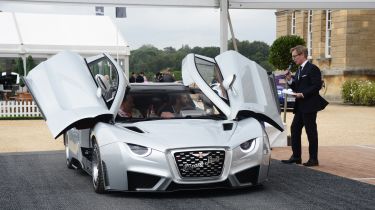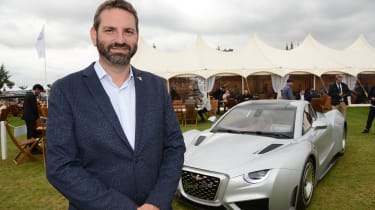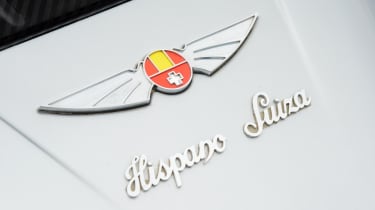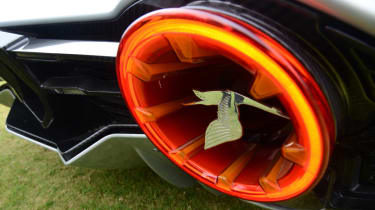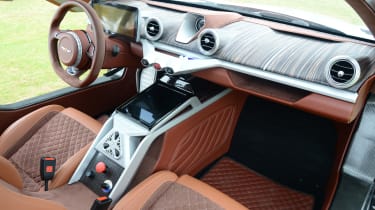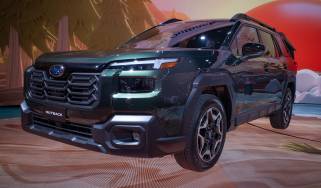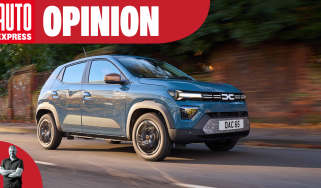The electric rebirth of Hispano Suiza
We get up close and personal with the Hispano Suiza’s new electric car - the Carmen, and learn more about the historic brand’s ambitious plans
Say hello to the new Hispano Suiza Carmen, an obscenely powerful electric hypercar costing well into seven figures. Just a handful will be built, and it claims to offer a driving experience like no other. In other words, it sounds like one of many recent hypercar upstarts destined for five minutes of fame before being filed away alongside a host of other dormant projects and ultimately forgotten.
For Hispano Suiza, however, things might be different. The brand is steeped with heritage in the automotive industry and beyond, and the Carmen marks a resurgence, rather than a beginning. Hispano Suiza produced its first in a long line of luxury cars in 1904, which preceded a foray into aviation in World War I. The company made more than 50,000 aeroplane engines in the period, and even built the machine guns mounted to many Spitfires in World War II.
By that time, its cars were already established as icons of luxury and performance. The H6 was a race-winning, six-cylinder behemoth that counted King Alfonso XIII of Spain among its drivers, and formed the basis for the most iconic model in the marque’s history. Revealed in 1932, the H6B Dubonnet Xenia was a cutting-edge, 110mph Art Deco piece, with a revolutionary independent coil spring suspension set-up designed by Bugatti Grand Prix racing driver André Dubonnet. The model was a one-off, clothed in a highly aerodynamic, coachbuilt body with cues from the brand’s aviation heritage. The wraparound windscreen and teardrop silhouette hint at Hispano Suiza’s involvement with fighter aircraft, an enterprise that separated from the automotive division after the Spanish Civil War. Unfortunately, trading and financial struggles after WWII brought an end to what was then one of the world’s great car-making endeavours.
Approach the new Carmen and it’s easy to imagine the astonishment of those who set eyes on the Dubonnet Xenia almost a century ago. This is a vehicle for the extroverted, if there ever was one. The project is led by Miguel Suque Mateu, great-grandson of the company’s founder, and looks to follow the thread of its pioneering pre-war models. It was revealed in production form for the first time at Salon Privé, which took place at Blenheim Palace in September, with chief technical officer Joan Orus there to unravel the details.
Immediately, the proportions look unlike anything else on the market. The nose is bluff and aggressive, with sharp, high cheekbones that mask the car’s width. The sculpture gets more extreme the further rearwards you look; it has the presence of a coachbuilt piece, but the tapering metalwork stretched over the rear wheels, plus an abrupt, squared-off glasshouse, gives an awkward stance from some angles.
The design is at least faithful to the brand’s lineage. The teardrop profile takes inspiration from the Dubonnet Xenia, and the rear light clusters house a Hispano Suiza stork logo in the centre. The badge pays tribute to the French squadron emblem on a Hispano Suiza-powered WWI fighter plane, and is littered throughout the new hypercar. The Carmen takes an unflinchingly bold approach in its design, and although the styling is unusual, there’s certainly no mistaking it for another cookie-cutter electric hypercar.
But why is now the right time for a resurgence? The brand hasn’t been active in the luxury car market since the war. According to Orus, the revival is not a chance to create a record-breaking vehicle, or boost the company’s bottom line. “The Carmen exists because of a promise made by Miguel Suque Mateu to his mother, to put his family’s brand back on the streets,” he says. The car shares its name with Mateu’s mother, who passed away in 2018, and fulfils that promise. Orus reveals that while the firm’s aviation division survived beyond the Second World War, the automotive brand is being revived through a separate company.
He speaks of the founding family with great respect – it’s clear that the project holds its ancestral ties dear – and when pressed on a bizarre decade-long legal feud with a Swiss company started by former VW-Audi design chief Erwin Leo Himmel that claimed the rights to use the Hispano Suiza name, Orus is ardently protective. “They do not have the history and they are not part of the family,” he says, but admits there are “ongoing discussions” between the Hispano Suiza family and the Swiss concern. The feud was aired most recently at the 2019 Geneva Motor Show when both presented Hispano Suiza-badged cars, and the Swiss company’s Maguari HS1 GTC remains on sale.
That’s one for the legal eagles though, and we’re here to study the Carmen. Much as the marque’s heritage is key to helping the car stand out, it’s conceived as a top-flight supercar and must be up to the task in pure performance terms. Happily, the car isn’t short on firepower, but there’s an interesting change of approach compared with others in this super-exclusive segment.
The Carmen generates 1,005bhp, with a sportier “Boulogne” version producing 1,100bhp. While these are explosive, the figures aren’t wildly ambitious; some of today’s hypercars produce double that. However, what sets the Carmen apart is that, unusually, drive is sent to the rear wheels only. More power, more traction and more impressive performance could be achieved with additional motors and four-wheel drive – a point we put to Orus, who responded: “It’s a car that must be fun. We are not looking for record-breaking acceleration, we want the Carmen to be a car that customers love to drive, so rear-wheel drive was perfect. We could put extra motors at the front for 2,000 horsepower with no problems, but that’s not what we wanted.”
The Carmen, then, is being pitched a driver’s car, and not the showpiece for collectors one might expect. Inevitably, as Orus concedes, a low-volume hypercar will invite such buyers, but the car is designed to be driven, trading absolute performance for engagement – a refreshing approach today. Motorsport expertise underpins the project, too; Hispano Suiza’s technical partner is QEV Technologies, and the firm used its Formula E background to optimise the Carmen’s powertrain. The car has two independent motors on each rear wheel, which allowed QEV to develop a bespoke torque-vectoring programme to maximise cornering ability.
The Carmen at Salon Privé is an ex-development car, and whispers suggest that it’ll find its way into the hands of the CEO once the project has been completed. It’s well finished up close, aside from some rudimentary switchgear, and Joan promises that customer cars will be better still. The pandemic has shifted last year’s planned global release to this year, but Hispano Suiza says it has sold the first two cars already, affirming that the revival is tangible. Given the very low production volume, buyers are given huge scope to customise their cars, and no two Carmens will be alike.
There is a potential sticking point, however. Given the rapid development of EV powertrains, there is a suspicion that the latest, tech-laden supercars will not age with the grace of their more analogue predecessors. To do justice to the brand’s history, the Carmen must be a timeless piece, so Hispano Suiza is ensuring that its technology won’t be obsolete in a few years. The carbon-fibre battery housing has been designed to take improved battery packs as the technology progresses, future-proofing the powertrain.
This keeps the Carmen’s GT credentials firmly in mind, and should bring range improvements in the future. Orus emphasises that, although driver engagement is the focus, the car has also been designed to cross continents in supreme comfort, in the same vein as past Hispano Suizas. “We wanted the car to be comfortable for the driver, as well as fast. The customer should be able to drive 300 or 400 kilometres on the weekend, and we have designed the suspension, brakes and steering to be comfortable.”
And on cue, the automatic butterfly-hinged doors opened and it was time to step inside the new Carmen. The driving environment is opulent, with swathes of wood, leather and metal. The angular switchgear and centre console design are at odds with the swooping exterior lines, but the ambience is spectacular. The windscreen is incredibly shallow, though, and Joan tells me that a glass roof has been installed to compensate for the slightly intimidating view out. However, to my eye, the flat rectangular gauge cluster display is jarring against the rest of the cabin, and the upward-facing infotainment touchscreen is likely to catch reflections when on the move – not ideal when you’re trying to operate a 1,005bhp, limited-run slice of exotica.
Dulling the excitement slightly is a set of air vents from the previous Mercedes C-Class, and a steering wheel from a 10-year-old Audi A3. However, Joan tells me that the scope for customisation is almost endless. The interior can be trimmed in almost any material – even crocodile leather.
With development of the Carmen complete, Hispano Suiza is turning to the task of selling all 25 examples at over 1.5 million Euros apiece. But as a resurgent brand, surely a single, hyper-exclusive model is not enough to re-establish it? Joan agrees: “We have not revived the brand to create a small number of cars then disappear, so more models will come in the future”. When pressed, he revealed that the next car will carry over the ethos of the Carmen to a more accessible price bracket. Over to you, Hispano Suiza...
Now read about Hispano Suiza's €2.2million Maguari HS1 GTC supercar
Find a car with the experts

